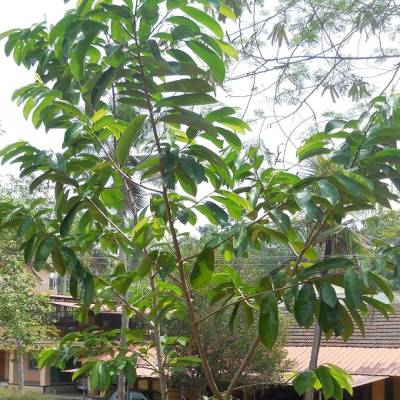Distribution and habitat: Native to tropical areas in South and North America. Seen throughout tropical and subtropical parts of the world, including India, Malaysia, Nigeria, Australia and Africa.
Botany:Evergreen tree with 5–8 m height
- Leaf: Large dark green glossy leaves.
- Flower: Single yellow flowers on woody stalks (pedicels). Three outer petals are broadly ovate with heart-shaped base, inner 3 also large, elliptical and rounded.
- Fruit: Edible, large, oval or heart-shaped and green in color, frequently irregular lopsided composite. Fusion of many fruitlets. Weigh more than 4 kg and the diameter varies between 15 and 20 cm. The fruit pulp consists of white fibrous juicy segments surrounding an elongated receptacle. In each fertile segment, there is a single oval, smooth hard, black seed.5-200 seeds from a single fruit. The reticulated leathery-looking skin has short spines.
Chemical constituents: Tannins, steroids and cardiac glycosides are the major phytochemical compounds. Alkaloids, megastigmanes, flavonol triglycosides, phenolics, cyclopeptides. More than 100 annonaceous acetogenins have been isolated from leaves, barks, seeds, roots and fruits.
Uses: Anticancerous, anticonvulsant, anti-arthritic, antiparasitic, antimalarial, hepatoprotective and antidiabetic, analgesic hypotensive, anti-inflammatory, and immune enhancing effects. Used of treatment of Arthritis, asthma, bile insufficiency, cancer, diarrhea, dysentery, fever, heart problems, kidney problems, lactation aid, lice, liver disorders, malaria, pain, ringworm, scurvy, stomach problems, and as a sedative.
Propagation: Seeds, It can be propagated by air layering, budding or through cuttings.
Planting: Spacing of 4-6 m

